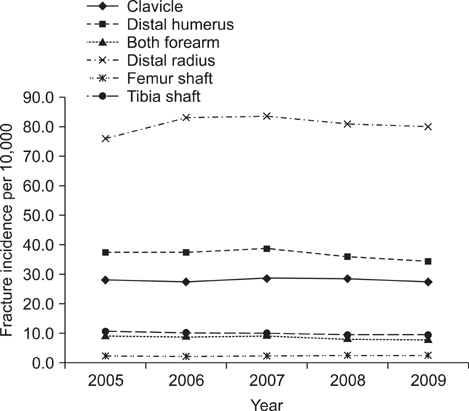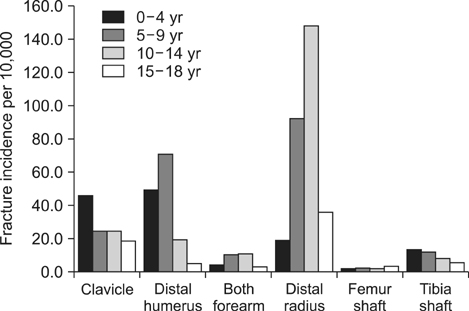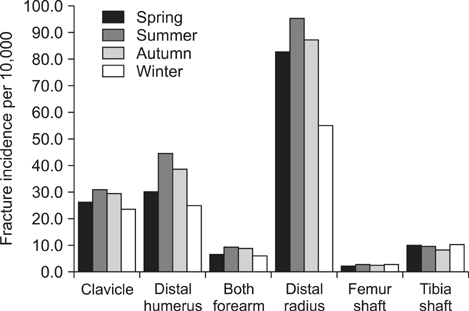Clin Orthop Surg.
2013 Sep;5(3):161-166. 10.4055/cios.2013.5.3.161.
Incidence Patterns of Pediatric and Adolescent Orthopaedic Fractures According to Age Groups and Seasons in South Korea: A Population-Based Study
- Affiliations
-
- 1Department of Orthopedic Surgery, Seoul National University Bundang Hospital, Seongnam, Korea. oasis100@empal.com
- 2Department of Orthopedic Surgery, Seoul National University Children's Hospital, Seoul, Korea.
- 3Department of Orthopaedic Surgery, Ulsan Hospital, Ulsan, Korea.
- 4Department of Orthopaedic Surgery, Kwandong University Myungji Hospital, Goyang, Korea.
- 5Department of Orthopaedic Surgery, Dongguk University Ilsan Hospital, Goyang, Korea.
- 6Department of Orthopaedic Surgery, Inha University Hospital, Incheon, Korea.
- KMID: 1705540
- DOI: http://doi.org/10.4055/cios.2013.5.3.161
Abstract
- BACKGROUND
Fractures which need urgent or emergency treatment are common in children and adolescents. This study investigated the incidence patterns of pediatric and adolescent orthopaedic fractures according to age groups and seasons in South Korea based on population data.
METHODS
Data on the number of pediatric and adolescent patients under the age of 18 years who utilized medical services due to fractures were retrieved from the Health Insurance Review and Assessment service in South Korea. The data included four upper extremity and two lower extremity fractures according to four age groups (0-4 years, 5-9 years, 10-14 years, and 15-18 years). Incidences of the fractures were calculated as the incidence per 10,000 per year, and patterns according to age groups and seasons were demonstrated.
RESULTS
The annual incidence of clavicle, distal humerus, both forearm bone, distal radius, femoral shaft and tibial shaft fractures were 27.5, 34.6, 7.7, 80.1, 2.5, and 9.6 per 10,000 per year in children and adolescents, respectively. Clavicle and distal radius fractures showed significant seasonal variation for all age groups but femoral shaft fracture showed no significant seasonal variation for any of the age groups.
CONCLUSIONS
The four upper extremity fractures tended to show greater variations than the two lower extremity fractures in the nationwide database in South Korea. The study results are believed to be helpful in the planning and assignment of medical resources for fracture management in children and adolescents.
MeSH Terms
Figure
Cited by 2 articles
-
The Pattern of Occurrence of Fractures in Children and Adolescents and Its Managements Based on the Database of the Health Insurance Review and Assessment Service
Yong-Wook Kwon, Soon-Hyuck Lee, Hyun-Woo Kim, Jin-Ho Hwang
J Korean Fract Soc. 2014;27(4):308-314. doi: 10.12671/jkfs.2014.27.4.308.Comparison of Pediatric Distal Radius Fracture Patterns according to Age
Kyung-Sub Song, Seung-Hwan Lee, Byeong-Mun Park, Su-Keon Lee, Bong-Seok Yang, Ji-Hyeon Kim
Arch Hand Microsurg. 2019;24(2):120-125. doi: 10.12790/ahm.2019.24.2.120.
Reference
-
1. Valerio G, Galle F, Mancusi C, et al. Pattern of fractures across pediatric age groups: analysis of individual and lifestyle factors. BMC Public Health. 2010; 10:656.
Article2. Wareham K, Johansen A, Stone MD, Saunders J, Jones S, Lyons RA. Seasonal variation in the incidence of wrist and forearm fractures, and its consequences. Injury. 2003; 34(3):219–222.
Article3. Atherton WG, Harper WM, Abrams KR. A year's trauma admissions and the effect of the weather. Injury. 2005; 36(1):40–46.
Article4. Ferreira PC, Amarante JM, Silva AC, Pereira JM, Cardoso MA, Rodrigues JM. Etiology and patterns of pediatric mandibular fractures in Portugal: a retrospective study of 10 years. J Craniofac Surg. 2004; 15(3):384–391.
Article5. Brudvik C, Hove LM. Childhood fractures in Bergen, Norway: identifying high-risk groups and activities. J Pediatr Orthop. 2003; 23(5):629–634.
Article6. Lyons RA, Delahunty AM, Kraus D, et al. Children's fractures: a population based study. Inj Prev. 1999; 5(2):129–132.
Article7. Hove LM, Brudvik C. Displaced paediatric fractures of the distal radius. Arch Orthop Trauma Surg. 2008; 128(1):55–60.
Article8. Rennie L, Court-Brown CM, Mok JY, Beattie TF. The epidemiology of fractures in children. Injury. 2007; 38(8):913–922.
Article9. Kramhoft M, Bodtker S. Epidemiology of distal forearm fractures in Danish children. Acta Orthop Scand. 1988; 59(5):557–559.
Article10. Landin LA. Fracture patterns in children: analysis of 8,682 fractures with special reference to incidence, etiology and secular changes in a Swedish urban population 1950-1979. Acta Orthop Scand Suppl. 1983; 202:1–109.11. Thomas EM, Tuson KW, Browne PS. Fractures of the radius and ulna in children. Injury. 1975; 7(2):120–124.
Article12. Bulajic-Kopjar M. Seasonal variations in incidence of fractures among elderly people. Inj Prev. 2000; 6(1):16–19.
Article13. Crawford JR, Parker MJ. Seasonal variation of proximal femoral fractures in the United Kingdom. Injury. 2003; 34(3):223–225.
Article14. Thompson PW, Taylor J, Dawson A. The annual incidence and seasonal variation of fractures of the distal radius in men and women over 25 years in Dorset, UK. Injury. 2004; 35(5):462–466.
Article15. Douglas S, Bunyan A, Chiu KH, Twaddle B, Maffulli N. Seasonal variation of hip fracture at three latitudes. Injury. 2000; 31(1):11–19.
Article16. Chiu KY, Ng TP, Chow SP. Seasonal variation of fractures of the hip in elderly persons. Injury. 1996; 27(5):333–336.
Article17. Jacobsen SJ, Goldberg J, Miles TP, Brody JA, Stiers W, Rimm AA. Seasonal variation in the incidence of hip fracture among white persons aged 65 years and older in the United States, 1984-1987. Am J Epidemiol. 1991; 133(10):996–1004.
Article18. Ogundare BO, Bonnick A, Bayley N. Pattern of mandibular fractures in an urban major trauma center. J Oral Maxillofac Surg. 2003; 61(6):713–718.
Article19. Bischoff-Ferrari HA, Orav JE, Barrett JA, Baron JA. Effect of seasonality and weather on fracture risk in individuals 65 years and older. Osteoporos Int. 2007; 18(9):1225–1233.
Article20. Rális ZA. Epidemic of fractures during period of snow and ice. Br Med J (Clin Res Ed). 1981; 282(6264):603–605.
Article21. Ralis ZA, Barker EA, Leslie IJ, Morgan WJ, Ross AC, White SH. Snow-and-ice fracture in the UK, a preventable epidemic. Lancet. 1988; 1(8585):589–590.
Article22. Jacobsen SJ, Sargent DJ, Atkinson EJ, O'Fallon WM, Melton LJ 3rd. Contribution of weather to the seasonality of distal forearm fractures: a population-based study in Rochester, Minnesota. Osteoporos Int. 1999; 9(3):254–259.
Article23. Jacobsen SJ, Sargent DJ, Atkinson EJ, O'Fallon WM, Melton LJ 3rd. Population-based study of the contribution of weather to hip fracture seasonality. Am J Epidemiol. 1995; 141(1):79–83.
Article24. Ivers RQ, Cumming RG, Mitchell P, Attebo K. Visual impairment and falls in older adults: the Blue Mountains Eye Study. J Am Geriatr Soc. 1998; 46(1):58–64.
Article25. Schott GD, Wills MR. Muscle weakness in osteomalacia. Lancet. 1976; 1(7960):626–629.
Article26. Landin LA, Danielsson LG. Children's ankle fractures: classification and epidemiology. Acta Orthop Scand. 1983; 54(4):634–640.
Article27. Pramyothin P, Techasurungkul S, Lin J, et al. Vitamin D status and falls, frailty, and fractures among postmenopausal Japanese women living in Hawaii. Osteoporos Int. 2009; 20(11):1955–1962.
Article28. Hill TR, McCarthy D, Jakobsen J, Lamberg-Allardt C, Kiely M, Cashman KD. Seasonal changes in vitamin D status and bone turnover in healthy Irish postmenopausal women. Int J Vitam Nutr Res. 2007; 77(5):320–325.
Article29. Mayranpaa MK, Makitie O, Kallio PE. Decreasing incidence and changing pattern of childhood fractures: a population-based study. J Bone Miner Res. 2010; 25(12):2752–2759.
Article
- Full Text Links
- Actions
-
Cited
- CITED
-
- Close
- Share
- Similar articles
-
- A Clinical Study of the Fracture Patterns in Children
- Analysis of 809 Facial Bone Fractures in a Pediatric and Adolescent Population
- Incidence of Hip Fractures in Jeju Island, South Korea: A Prospective Study (2002-2006)
- Incidence and Seasonal Variation of Distal Radius Fractures in Korea: a Population-based Study
- Trend in the Age-Adjusted Incidence of Hip Fractures in South Korea: Systematic Review




